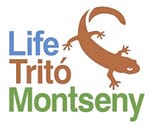Slider 3
Life Tritó Montseny
Un símbol de la natura del Montseny
Subbanner
LIFE15 NAT/ES/000757
Project of conservation of an only species to the world
Breadcrumb
Evolution
Evolution of the project Life Tritó Montseny
Asset Publisher


Conference on amphibians
23/10/2020 09:43 h.
The Life Tritó Montseny, present at the III Conference for the conservation of amphibians
The Aranzadi Science Society of the Basque Country organized the III Conference for the conservation of amphibians. Monitoring of threatened populations. They were held on 16 and 17 October at its headquarters in Aranzadi (Alto de Zorroaga).
The specialist and collaborator of the Life Tritó Montseny project, Albert Montori, from the Grup de Recerca de l'Escola de la Natura de Parets de Vallès (GRENP), presented the study and monitoring of the newts, the Pyrenean newt (Calotriton asper) and the Montseny newt (Calotriton arnoldi). The study is based on the monitoring of the populations of the torrentine urodele species, which requires specific methodologies that are difficult to reproduce for other amphibian species.
The difficulty of locating adult specimens and their larvae requires very intensive monitoring in the short and long term. For the Pyrenean newt (Calotriton asper), the results of the monitoring carried out in the Cadí-Moixeró Natural Park are presented, in the long term to know the temporal evolution of a population, and in the short term to characterize the distribution of its populations.
In reference to the Montseny newt (Calotriton arnoldi), the study presents outstanding aspects of the Life Tritó Montseny project focused on the monitoring of the only seven populations of this species in the massif, such as the exact determination of its presence in the area, new techniques for the characterization of the species' biology and the selection of suitable habitats for the creation of new populations.
Poster of the study presented by A. Montori. Author: GRENP
On Friday, October 16, seven presentations were made and a closing round table discussion was held on monitoring programs for catalogued amphibian species. The following day, Saturday October 17th, four presentations were made and the closing round table to discuss the main and new threats by amphibians.
The III Conference for the conservation of amphibians. Monitoring of threatened populations brought together some fifty scientists and herpetology specialists, some 25-30 of whom did so in person and the rest virtually through Zoom.
III Conference for the conservation of amphibians. Monitoring of threatened populations. Photo: GRENP
Amphibians, the most threatened vertebrates
As stated by the Aranzadi Science Society, amphibians are the most threatened group of vertebrates, sensitive to almost all threats affecting biodiversity, both global and local. Even when they generate hobbies, they often do so as objects of collection, with dire consequences.
However, they do not enjoy the popular sympathy that turns other taxa into protagonists of conservationist imagery. Perhaps for this reason, the information available on the status of their populations is scarce and monitoring programs are few. Paradoxically, efforts to conserve these species would guarantee the conservation of many others, as well as the landscapes that host them. For this reason, it is necessary to know the situation of their populations and the factors that threaten their permanence, although, in order to establish monitoring plans, both to alleviate the current lack of information and to avoid future ones, it is necessary to know the difficulties involved in monitoring their populations.




